Sea Surface Salinity Anomaly in the Bay of Bengal during the 2010 Extremely Negative IOD Event
Abstract
:1. Introduction
2. Data and Methods
2.1. Data
2.2. Methods
2.2.1. Anomalous Mixed Layer Salt Budget
2.2.2. Anomalous Transports of Salinity and Freshwater
2.2.3. Moist Static Energy (MSE)
3. Results
3.1. Distribution of Salinity Anomalies for Summer and Autumn 2010
3.2. Mixed Layer Anomalous Salt Budget
3.3. Anomalies of Currents in 2010
3.4. Precipitation and River Discharge Anomalies in 2010
4. Discussion
5. Conclusions
Author Contributions
Funding
Data Availability Statement
Acknowledgments
Conflicts of Interest
References
- Varkey, M.; Murty, V.; Suryanarayana, A. Physical oceanography of the Bay of Bengal and Andaman Sea. Oceanogr. Mar. Biol. Annu. Rev. 1996, 34, 1–10. [Google Scholar]
- Akhil, V.P.; Durand, F.; Lengaigne, M.; Keerthi, M.G.; Gopalakrishna, V.V.; Deltel, C.; Papa, F.; de Boyer Montégut, C. A modeling study of the processes of surface salinity seasonal cycle in the Bay of Bengal. J. Geophys. Res. Ocean. 2014, 119, 3926–3947. [Google Scholar] [CrossRef] [Green Version]
- Vinayachandran, P.N.; Murty, V.S.N.; Ramesh Babu, V. Observations of barrier layer formation in the Bay of Bengal during summer monsoon. J. Geophys. Res. Ocean. 2002, 107, SRF 19-11–SRF 19-19. [Google Scholar] [CrossRef]
- Thadathil, P.; Muraleedharan, P.M.; Rao, R.R.; Somayajulu, Y.K.; Reddy, G.V.; Revichandran, C. Observed seasonal variability of barrier layer in the Bay of Bengal. J. Geophys. Res. 2007, 112, C02009. [Google Scholar] [CrossRef]
- Wang, Q.; Dong, C.; Li, J.; Yang, J.; Tian, Q. Numerical study of the seasonal salinity budget of the upper ocean in the Bay of Bengal in 2014. J. Oceanol. Limnol. 2021, 39, 1169–1187. [Google Scholar] [CrossRef]
- Chaitanya, A.V.S.; Durand, F.; Mathew, S.; Gopalakrishna, V.V.; Papa, F.; Lengaigne, M.; Vialard, J.; Kranthikumar, C.; Venkatesan, R. Observed year-to-year sea surface salinity variability in the Bay of Bengal during the 2009–2014 period. Ocean Dyn. 2015, 65, 173–186. [Google Scholar] [CrossRef]
- Jinadasa, S.U.P.; Pathirana, G.; Ranasinghe, P.N.; Centurioni, L.; Hormann, V. Monsoonal impact on circulation pathways in the Indian Ocean. Acta Oceanol. Sin. 2020, 39, 103–112. [Google Scholar] [CrossRef]
- Jensen, T.G. Arabian Sea and Bay of Bengal exchange of salt and tracers in an ocean model. Geophys. Res. Lett. 2001, 28, 3967–3970. [Google Scholar] [CrossRef]
- McPhaden, M.J.; Wang, Y.; Ravichandran, M. Volume transports of the Wyrtki jets and their relationship to the Indian Ocean Dipole. J. Geophys. Res. Ocean. 2015, 120, 5302–5317. [Google Scholar] [CrossRef] [Green Version]
- Wyrtki, K. An equatorial jet in the Indian Ocean. Science 1973, 181, 262–264. [Google Scholar] [CrossRef]
- Rao, R.R. Seasonal variability of sea surface salinity and salt budget of the mixed layer of the north Indian Ocean. J. Geophys. Res. 2003, 108, 3009. [Google Scholar] [CrossRef]
- Grunseich, G.; Subrahmanyam, B.; Murty, V.S.N.; Giese, B.S. Sea surface salinity variability during the Indian Ocean Dipole and ENSO events in the tropical Indian Ocean. J. Geophys. Res. Ocean. 2011, 116, C11013. [Google Scholar] [CrossRef] [Green Version]
- Power, K.; Axelsson, J.; Wangdi, N.; Zhang, Q. Regional and Local Impacts of the ENSO and IOD Events of 2015 and 2016 on the Indian Summer Monsoon-A Bhutan Case Study. Atmosphere 2021, 12, 954. [Google Scholar] [CrossRef]
- Pant, V.; Girishkumar, M.S.; Udaya Bhaskar, T.V.S.; Ravichandran, M.; Papa, F.; Thangaprakash, V.P. Observed interannual variability of near-surface salinity in the Bay of Bengal. J. Geophys. Res. Ocean. 2015, 120, 3315–3329. [Google Scholar] [CrossRef]
- Behera, S.K.; Ratnam, J.V. Quasi-asymmetric response of the Indian summer monsoon rainfall to opposite phases of the IOD. Sci. Rep. 2018, 8, 123. [Google Scholar] [CrossRef] [Green Version]
- Klein, S.A.; Soden, B.J.; Lao, N. Remote Sea Surface Temperature Variations during ENSO: Evidence for a Tropical Atmospheric Bridge. J. Clim. 1999, 12, 917–932. [Google Scholar] [CrossRef]
- Srinivas, K.; Kumar, P.K.D.; Revichandran, C. ENSO signature in the sea level along the coastline of the Indian subcontinent. Indian J. Mar. Sci. 2005, 34, 25–36. [Google Scholar]
- Ummenhofer, C.C.; Sen Gupta, A.; Li, Y.; Taschetto, A.S.; England, M.H. Multi-decadal modulation of the El Niño–Indian monsoon relationship by Indian Ocean variability. Environ. Res. Lett. 2011, 6, 034006. [Google Scholar] [CrossRef]
- Jensen, T.G. Wind-Driven Response of the Northern Indian Ocean to Climate Extremes. J. Clim. 2007, 20, 2978–2993. [Google Scholar] [CrossRef] [Green Version]
- Akhil, V.P.; Vialard, J.; Lengaigne, M.; Keerthi, M.G.; Boutin, J.; Vergely, J.L.; Papa, F. Bay of Bengal Sea surface salinity variability using a decade of improved SMOS re-processing. Remote Sens. Environ. 2020, 248, 111964. [Google Scholar] [CrossRef]
- Li, Z.; Lian, T.; Ying, J.; Zhu, X.; Papa, F.; Xie, H.; Long, Y. The Cause of an Extremely Low Salinity Anomaly in the Bay of Bengal During 2012 Spring. J. Geophys. Res. Ocean. 2021, 126, e2021JC017361. [Google Scholar] [CrossRef]
- Fournier, S.; Vialard, J.; Lengaigne, M.; Lee, T.; Gierach, M.M.; Chaitanya, A.V.S. Modulation of the Ganges-Brahmaputra River Plume by the Indian Ocean Dipole and Eddies Inferred From Satellite Observations. J. Geophys. Res. Ocean. 2017, 122, 9591–9604. [Google Scholar] [CrossRef]
- Pujiana, K.; McPhaden, M.J. Intraseasonal Kelvin Waves in the Equatorial Indian Ocean and Their Propagation into the Indonesian Seas. J. Geophys. Res. Ocean. 2020, 125, e2019JC015839. [Google Scholar] [CrossRef]
- Huang, K.; Wang, D.; Wang, W.; Xie, Q.; Chen, J.; Chen, L.; Chen, G. Multi-scale variability of the tropical Indian Ocean circulation system revealed by recent observations. Sci. China Earth Sci. 2018, 61, 668–680. [Google Scholar] [CrossRef]
- Dandapat, S.; Chakraborty, A.; Kuttippurath, J. Interannual variability and characteristics of the East India Coastal Current associated with Indian Ocean Dipole events using a high resolution regional ocean model. Ocean Dyn. 2018, 68, 1321–1334. [Google Scholar] [CrossRef]
- Blunden, J.; Arndt, D.S.; Baringer, M.O. State of the climate in 2010. Bull. Am. Meteorol. Soc. 2011, 92, S1–S236. [Google Scholar] [CrossRef]
- Nyadjro, E.S.; Subrahmanyam, B. Spatial and temporal variability of central Indian Ocean salinity fronts observed by SMOS. Remote Sens. Environ. 2016, 180, 146–153. [Google Scholar] [CrossRef]
- Bonjean, F.; Lagerloef, G.S. Diagnostic model and analysis of the surface currents in the tropical Pacific Ocean. J. Phys. Oceanogr. 2002, 32, 2938–2954. [Google Scholar] [CrossRef]
- Zuo, H.; Balmaseda, M.A.; Tietsche, S.; Mogensen, K.; Mayer, M. The ECMWF operational ensemble reanalysis–analysis system for ocean and sea ice: A description of the system and assessment. Ocean Sci. 2019, 15, 779–808. [Google Scholar] [CrossRef] [Green Version]
- Hersbach, H.; Bell, B.; Berrisford, P.; Horányi, A.; Sabater, J.M.; Nicolas, J.; Radu, R.; Schepers, D.; Simmons, A.; Soci, C.; et al. Global Reanalysis: Goodbye ERA-Interim, Hello ERA5; ECMWF: Reading, UK, 2019; pp. 17–24. [Google Scholar] [CrossRef]
- Mahto, S.S.; Mishra, V. Does ERA-5 Outperform Other Reanalysis Products for Hydrologic Applications in India? J. Geophys. Res. Atmos. 2019, 124, 9423–9441. [Google Scholar] [CrossRef]
- Nyadjro, E.S.; Subrahmanyam, B.; Shriver, J.F. Seasonal variability of salt transport during the Indian Ocean monsoons. J. Geophys. Res. 2011, 116, C08036. [Google Scholar] [CrossRef]
- Yue, W.; Lin, L.; Xiaotong, Z. Influence of El Nino events on sea surface salinity over the central equatorial Indian Ocean. Env. Res 2020, 182, 109097. [Google Scholar] [CrossRef] [PubMed]
- Wijffels, S.E.; Schmitt, R.W.; Bryden, H.L.; Stigebrandt, A. Transport of Freshwater by the Oceans. J. Phys. Oceanogr. 1992, 22, 986–987. [Google Scholar] [CrossRef]
- Roman-Stork, H.L.; Subrahmanyam, B.; Murty, V.S.N. The Role of Salinity in the Southeastern Arabian Sea in Determining Monsoon Onset and Strength. J. Geophys. Res. Ocean. 2020, 125, e2019JC015592. [Google Scholar] [CrossRef]
- Trott, C.B.; Subrahmanyam, B.; Murty, V.S.N.; Shriver, J.F. Large-Scale Fresh and Salt Water Exchanges in the Indian Ocean. J. Geophys. Res. Ocean. 2019, 124, 6252–6269. [Google Scholar] [CrossRef]
- Steiner, A.L.; Pal, J.S.; Rauscher, S.A.; Bell, J.L.; Diffenbaugh, N.S.; Boone, A.; Sloan, L.C.; Giorgi, F. Land surface coupling in regional climate simulations of the West African monsoon. Clim. Dyn. 2009, 33, 869–892. [Google Scholar] [CrossRef]
- Geen, R. Forecasting South China Sea Monsoon Onset Using Insight from Theory. Geophys. Res. Lett. 2021, 48, e2020GL091444. [Google Scholar] [CrossRef]
- Vinayachandran, P.N.; Masumoto, Y.; Mikawa, T.; Yamagata, T. Intrusion of the Southwest Monsoon Current into the Bay of Bengal. J. Geophys. Res. Ocean. 1999, 104, 11077–11085. [Google Scholar] [CrossRef]
- Akhil, V.P.; Lengaigne, M.; Vialard, J.; Durand, F.; Keerthi, M.G.; Chaitanya, A.V.S.; Papa, F.; Gopalakrishna, V.V.; de Boyer Montégut, C. A modeling study of processes controlling the Bay of Bengal sea surface salinity interannual variability. J. Geophys. Res. Ocean. 2016, 121, 8471–8495. [Google Scholar] [CrossRef] [Green Version]
- Papa, F.; Bala, S.K.; Pandey, R.K.; Durand, F.; Gopalakrishna, V.V.; Rahman, A.; Rossow, W.B. Ganga-Brahmaputra river discharge from Jason-2 radar altimetry: An update to the long-term satellite-derived estimates of continental freshwater forcing flux into the Bay of Bengal. J. Geophys. Res. Ocean. 2012, 117. [Google Scholar] [CrossRef] [Green Version]
- Shetye, S.R. The movement and implications of the Ganges-Bramhaputra runoff on entering the Bay of Bengal. Curr. Sci. 1993, 64, 32–38. [Google Scholar]
- Vinayachandran, P.N.; Shankar, D.; Vernekar, S.; Sandeep, K.K.; Amol, P.; Neema, C.P.; Chatterjee, A. A summer monsoon pump to keep the Bay of Bengal salty. Geophys. Res. Lett. 2013, 40, 1777–1782. [Google Scholar] [CrossRef]
- Webber, B.G.M.; Matthews, A.J.; Vinayachandran, P.N.; Neema, C.P.; Sanchez-Franks, A.; Vijith, V.; Amol, P.; Baranowski, D.B. The Dynamics of the Southwest Monsoon Current in 2016 from High-Resolution In Situ Observations and Models. J. Phys. Oceanogr. 2018, 48, 2259–2282. [Google Scholar] [CrossRef]
- Li, Y.; Qiu, Y.; Hu, J.; Aung, C.; Lin, X.; Jing, C.; Zhang, J. The Strong Upwelling Event off the Southern Coast of Sri Lanka in 2013 and Its Relationship with Indian Ocean Dipole Events. J. Clim. 2021, 34, 3555–3569. [Google Scholar] [CrossRef]
- Sankar, S.; Kumar, M.R.R.; Reason, C. On the Relative Roles of El Nino and Indian Ocean Dipole Events on the Monsoon Onset over Kerala. 2011, 103, 359–374. Theor. Appl. Climatol. 2011, 103, 359–374. [Google Scholar] [CrossRef]
- Shenoi, S.; Shankar, D.; Gopalakrishna, V.; Durand, F. Role of ocean in the genesis and annihilation of the core of the warm pool in the southeastern Arabian Sea. Mausam 2005, 56, 147–160. [Google Scholar] [CrossRef]
- Krishna, S.M.; Suneel, V.; Gavaskar, S.S.M.; Anuradha, M.; Johnson, Z.; Girish, K.; Rajesh, S.; Ravichandran, M.; Pankajakshan, T.; Girishkumar, M.S.; et al. Reduced Near-Surface Thermal Inversions in 2005–06 in the Southeastern Arabian Sea (Lakshadweep Sea)*. J. Phys. Oceanogr. 2009, 39, 1184–1199. [Google Scholar] [CrossRef] [Green Version]
- Rao, R.R.; Ramakrishna, S.S.V.S. Observed seasonal and interannual variability of the near-surface thermal structure of the Arabian Sea Warm Pool. Dyn. Atmos. Ocean. 2017, 78, 121–136. [Google Scholar] [CrossRef]
- Durand, F. Impact of temperature inversions on SST evolution in the South-Eastern Arabian Sea during the pre-summer monsoon season. Geophys. Res. Lett. 2004, 31, L01305. [Google Scholar] [CrossRef]
- Shankar, D. Observational evidence for westward propagation of temperature inversions in the southeastern Arabian Sea. Geophys. Res. Lett. 2004, 31, L08305. [Google Scholar] [CrossRef] [Green Version]
- Sanilkumar, K.; Kumar, P.H.; Joseph, J.; Panigrahi, J. Arabian Sea mini warm pool during May 2000. Curr. Sci. 2004, 86, 180–184. [Google Scholar]
- Neema, C.P.; Hareeshkumar, P.V.; Babu, C.A. Characteristics of Arabian Sea mini warm pool and Indian summer monsoon. Clim. Dyn. 2011, 38, 2073–2087. [Google Scholar] [CrossRef] [Green Version]
- Shenoi, S.S.C.; Shankar, D.; Shetye, S.R. On the sea surface temperature high in the Lakshadweep Sea before the onset of the southwest monsoon. J. Geophys. Res. Ocean. 1999, 104, 15703–15712. [Google Scholar] [CrossRef]
- Nyadjro, E.S.; Subrahmanyam, B.; Murty, V.S.N.; Shriver, J.F. The role of salinity on the dynamics of the Arabian Sea mini warm pool. J. Geophys. Res. Ocean. 2012, 117, C09002. [Google Scholar] [CrossRef]
- Nagamani, P.V.; Ali, M.M.; Goni, G.J.; Udaya Bhaskar, T.V.S.; McCreary, J.P.; Weller, R.A.; Rajeevan, M.; Gopala Krishna, V.V.; Pezzullo, J.C. Heat content of the Arabian Sea Mini Warm Pool is increasing. Atmos. Sci. Lett. 2016, 17, 39–42. [Google Scholar] [CrossRef] [Green Version]
- Deepa, R.; Gnanaseelan, C.; Deshpande, M.; Salvekar, P.S. A Model Study on Understanding the Influence of Arabian Sea Mini Warm Pool on Monsoon Onset Vortex Formation. Pure Appl. Geophys. 2011, 169, 1693–1706. [Google Scholar] [CrossRef]

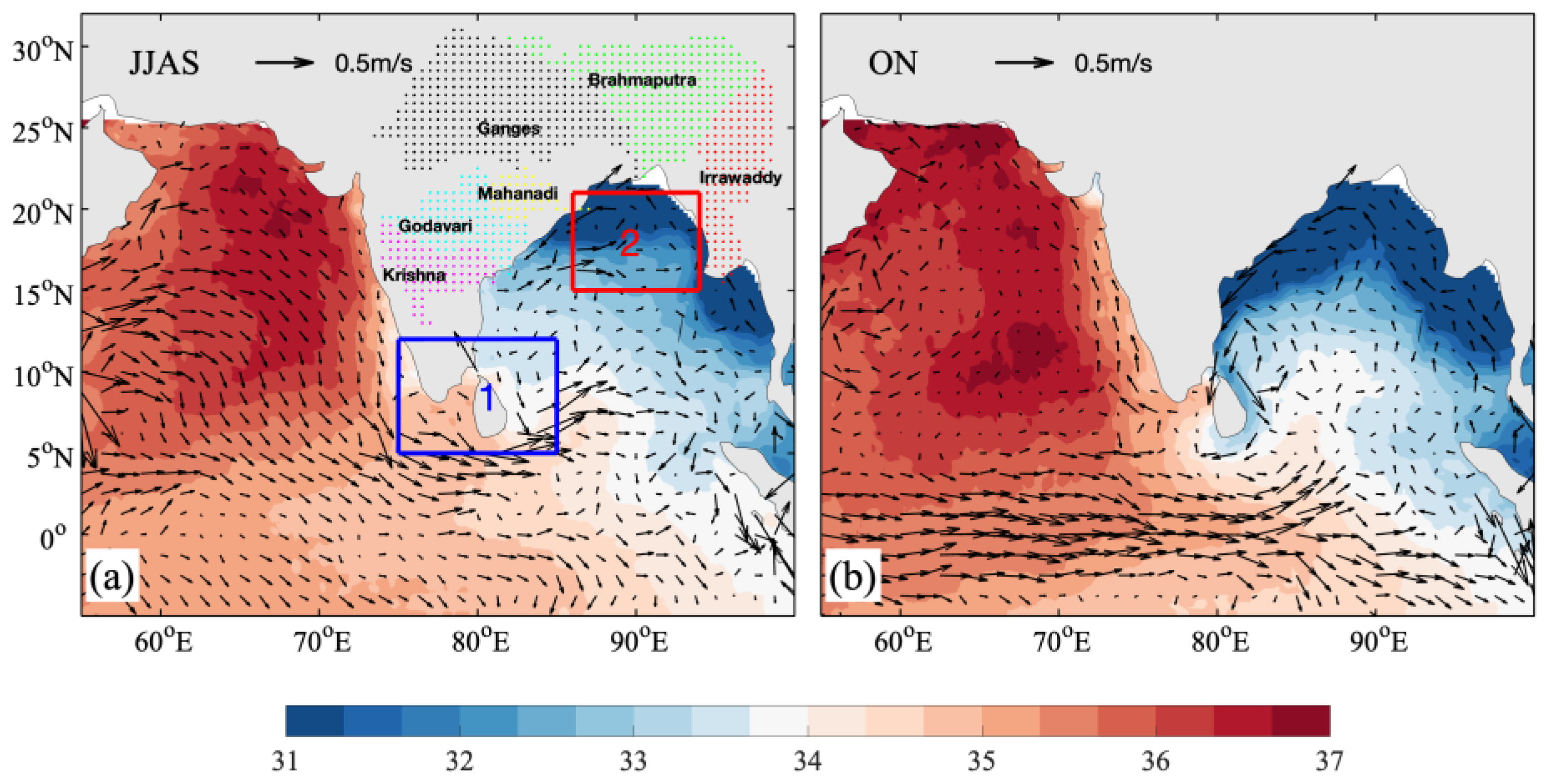


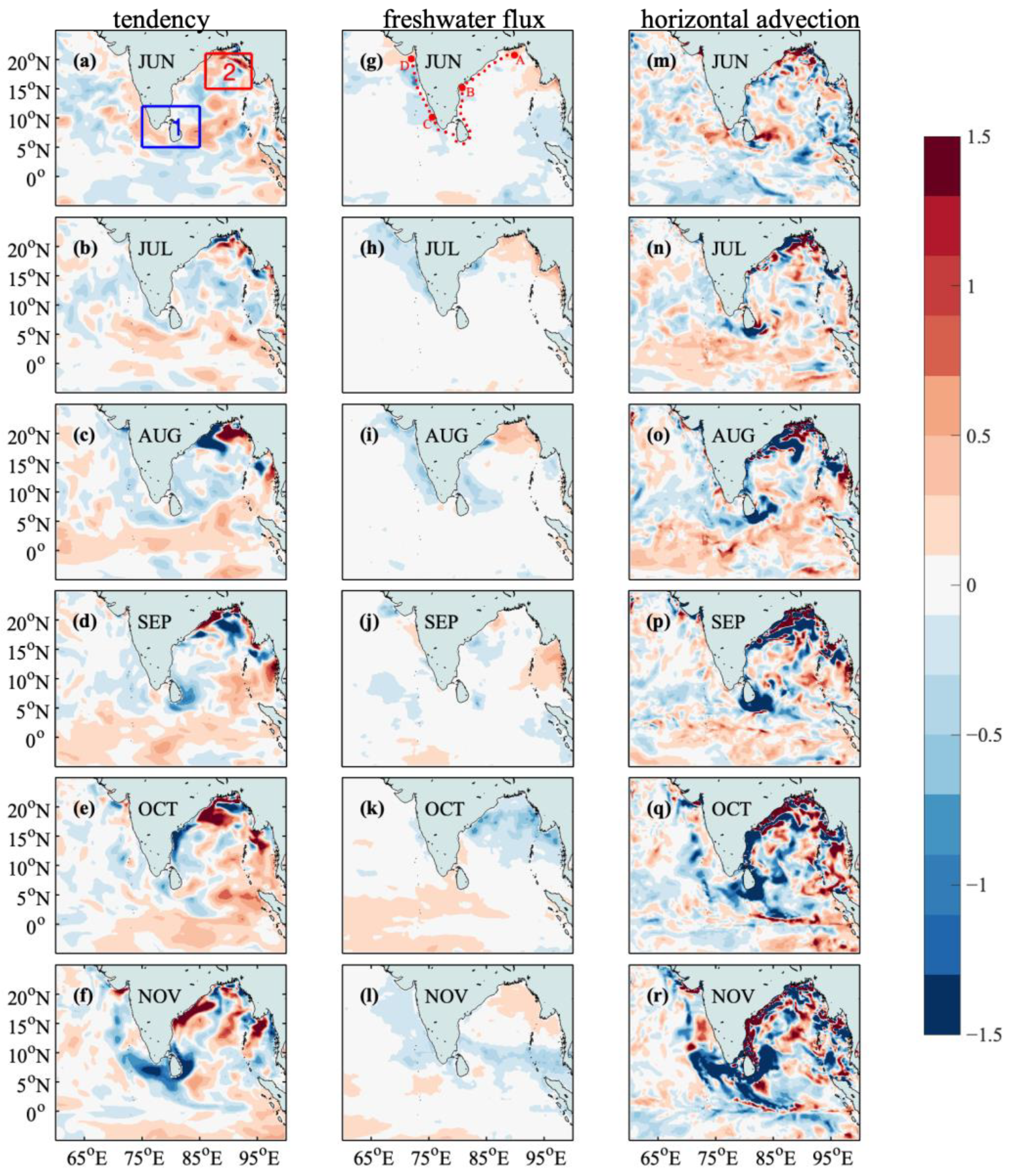

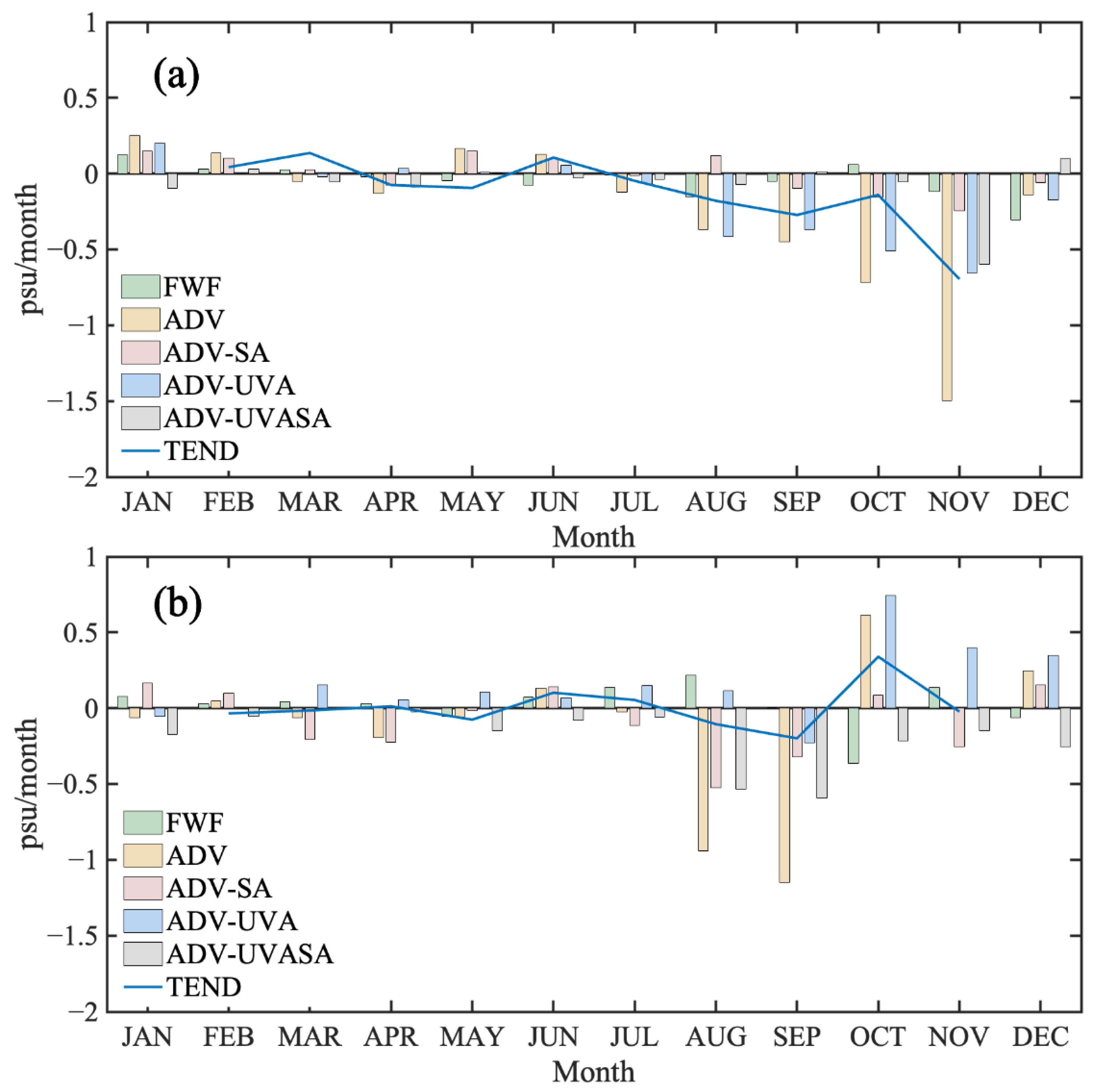
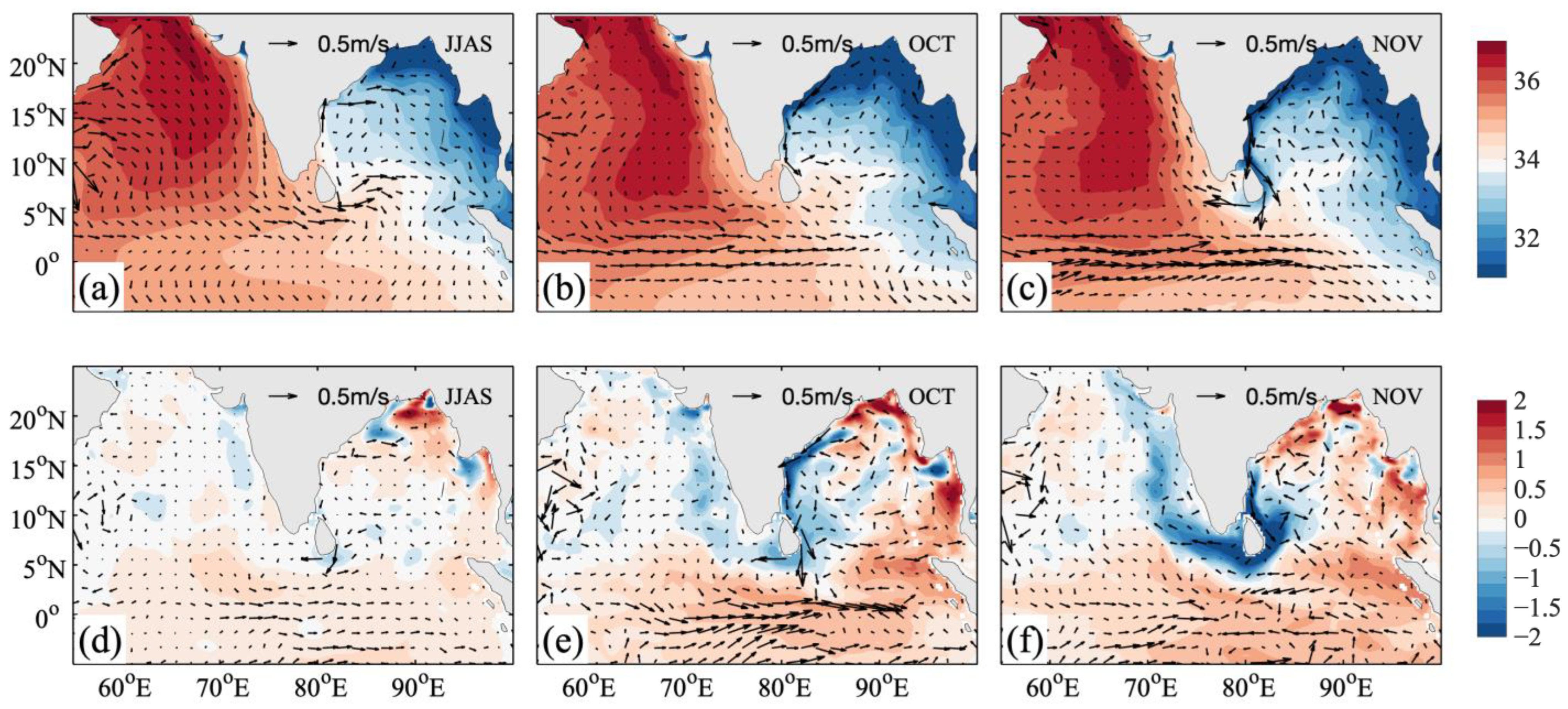
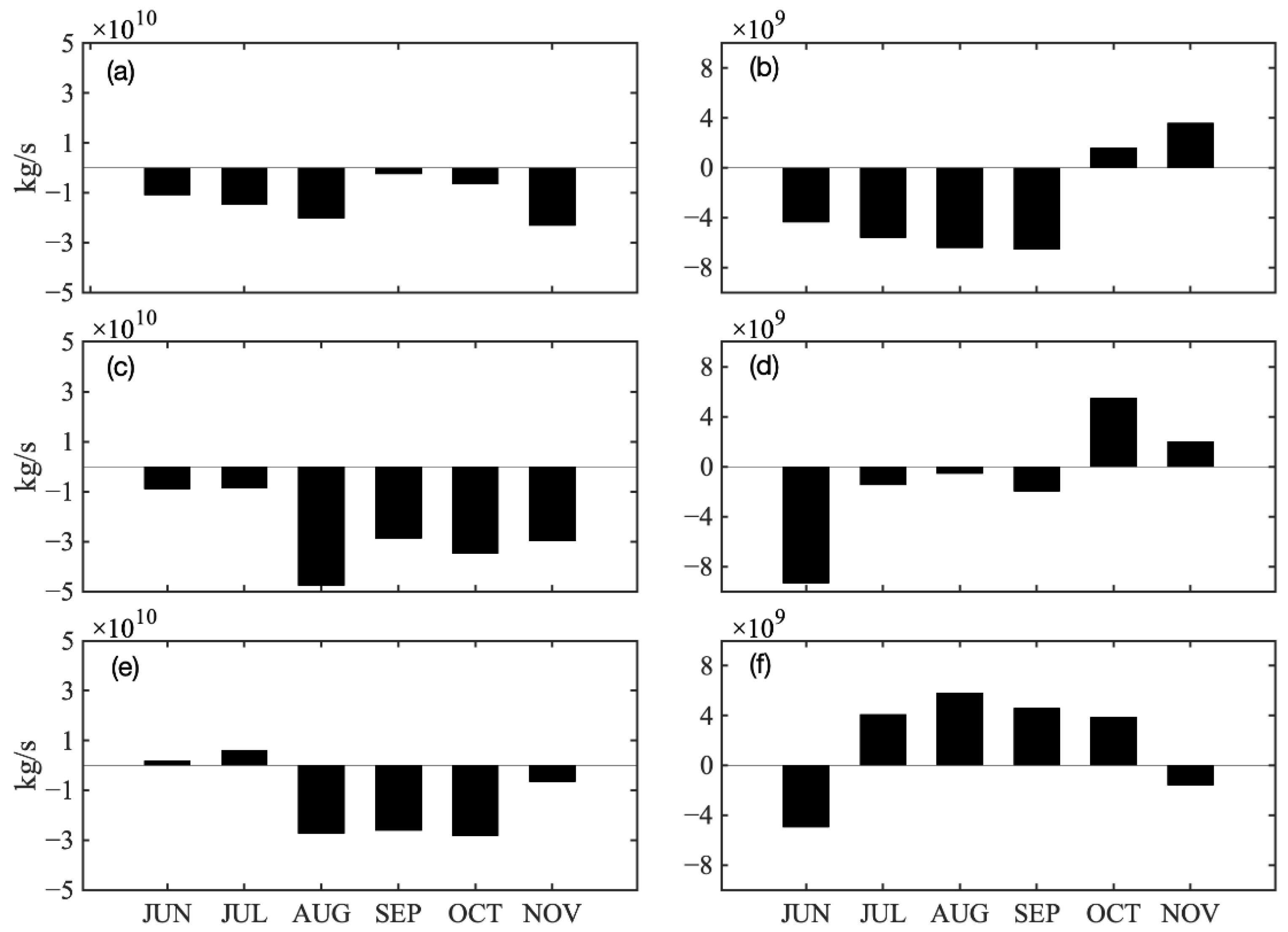

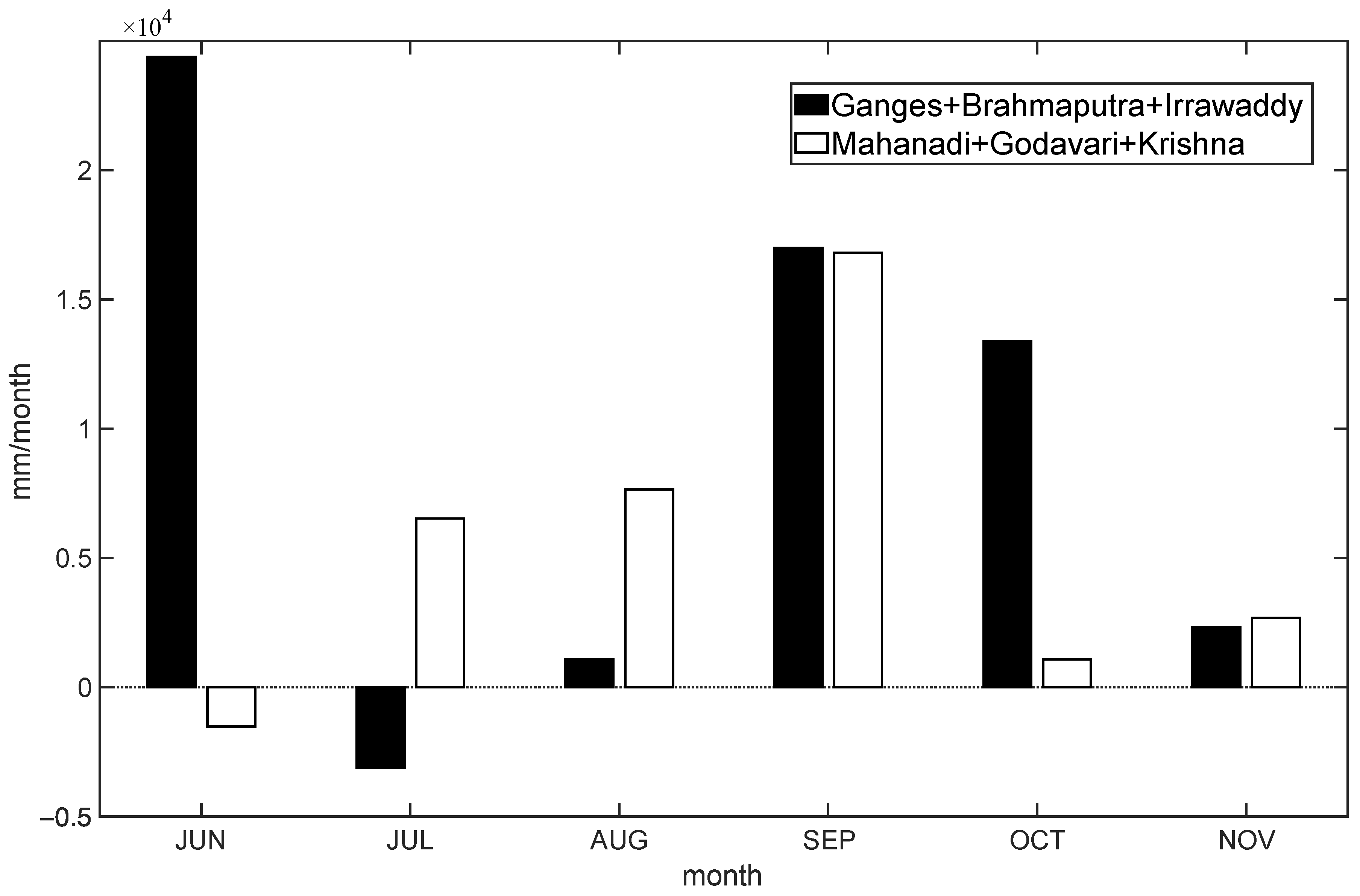

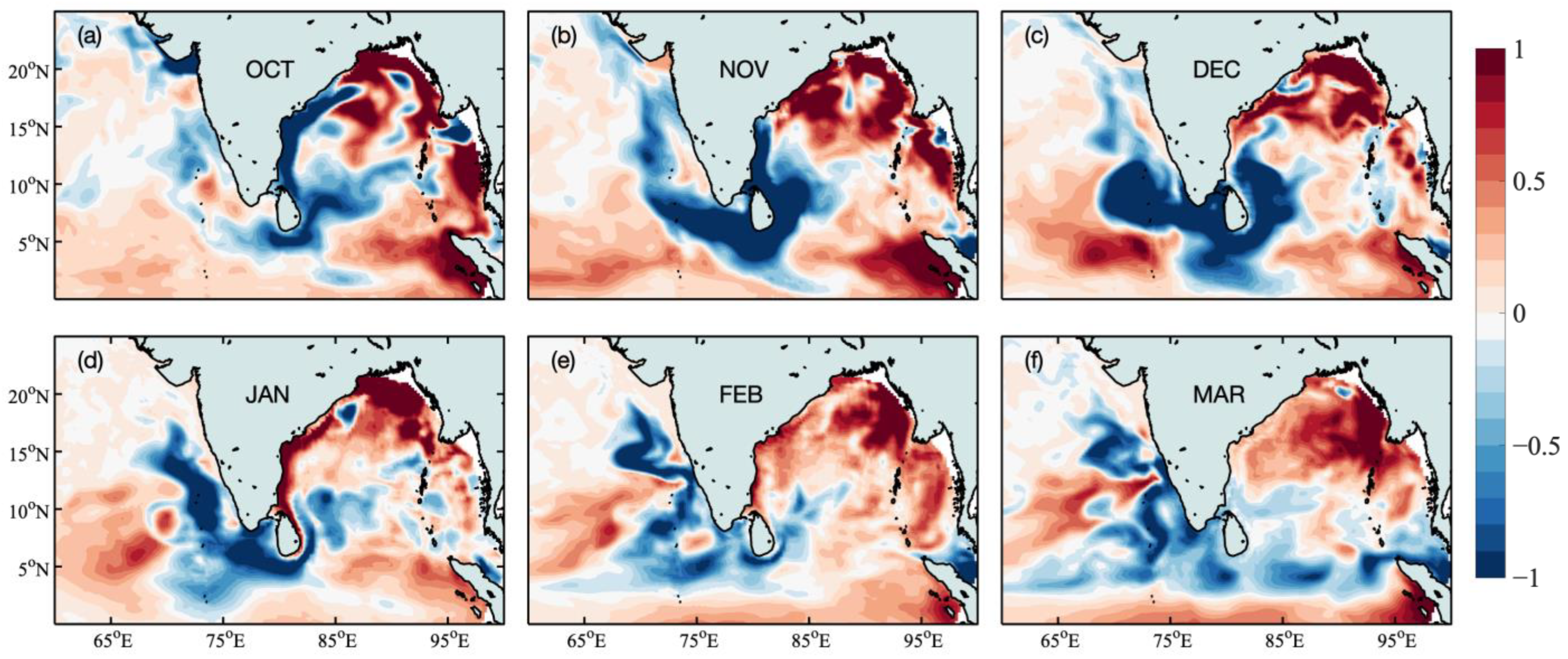

Publisher’s Note: MDPI stays neutral with regard to jurisdictional claims in published maps and institutional affiliations. |
© 2022 by the authors. Licensee MDPI, Basel, Switzerland. This article is an open access article distributed under the terms and conditions of the Creative Commons Attribution (CC BY) license (https://creativecommons.org/licenses/by/4.0/).
Share and Cite
Chen, S.; Cha, J.; Qiu, F.; Jing, C.; Qiu, Y.; Xu, J. Sea Surface Salinity Anomaly in the Bay of Bengal during the 2010 Extremely Negative IOD Event. Remote Sens. 2022, 14, 6242. https://doi.org/10.3390/rs14246242
Chen S, Cha J, Qiu F, Jing C, Qiu Y, Xu J. Sea Surface Salinity Anomaly in the Bay of Bengal during the 2010 Extremely Negative IOD Event. Remote Sensing. 2022; 14(24):6242. https://doi.org/10.3390/rs14246242
Chicago/Turabian StyleChen, Shuling, Jing Cha, Fuwen Qiu, Chunsheng Jing, Yun Qiu, and Jindian Xu. 2022. "Sea Surface Salinity Anomaly in the Bay of Bengal during the 2010 Extremely Negative IOD Event" Remote Sensing 14, no. 24: 6242. https://doi.org/10.3390/rs14246242
APA StyleChen, S., Cha, J., Qiu, F., Jing, C., Qiu, Y., & Xu, J. (2022). Sea Surface Salinity Anomaly in the Bay of Bengal during the 2010 Extremely Negative IOD Event. Remote Sensing, 14(24), 6242. https://doi.org/10.3390/rs14246242







